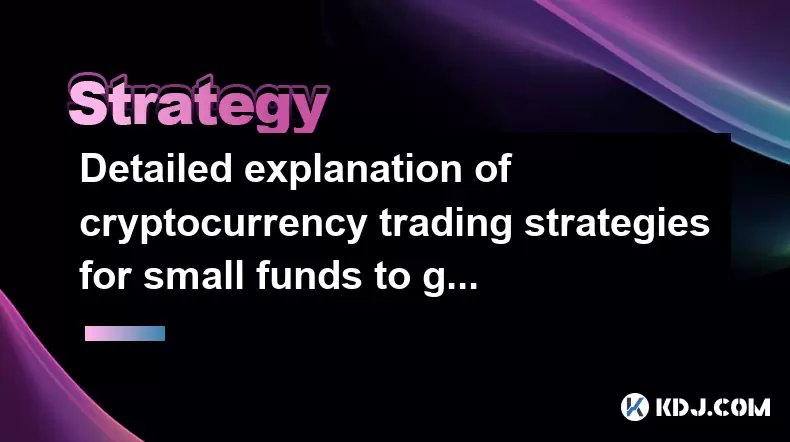-
 bitcoin
bitcoin $122025.899241 USD
-2.12% -
 ethereum
ethereum $4488.068729 USD
-4.11% -
 bnb
bnb $1315.348019 USD
8.65% -
 tether
tether $1.000457 USD
0.03% -
 xrp
xrp $2.875326 USD
-3.69% -
 solana
solana $222.043604 USD
-4.07% -
 usd-coin
usd-coin $0.999682 USD
0.00% -
 dogecoin
dogecoin $0.249887 USD
-5.62% -
 tron
tron $0.337379 USD
-2.59% -
 cardano
cardano $0.827763 USD
-5.06% -
 hyperliquid
hyperliquid $45.774531 USD
-2.43% -
 chainlink
chainlink $22.079309 USD
-5.87% -
 ethena-usde
ethena-usde $1.000156 USD
0.02% -
 sui
sui $3.482566 USD
-3.57% -
 stellar
stellar $0.386982 USD
-4.92%
Detailed explanation of cryptocurrency trading strategies for small funds to gain big returns
Trading crypto with small funds can be rewarding using strategies like scalping, swing trading, arbitrage, DCA, and staking to maximize returns while managing risk.
Jun 08, 2025 at 09:42 am

Trading cryptocurrencies with small funds and aiming for significant returns is a challenging yet potentially rewarding endeavor. The volatile nature of the cryptocurrency market presents both risks and opportunities, particularly for traders with limited capital. By employing strategic approaches tailored to small investments, traders can enhance their chances of achieving substantial gains. This article delves into various trading strategies that can be effectively used by those with small funds, providing a detailed explanation of how to leverage these methods for maximum returns.
Understanding the Basics of Cryptocurrency Trading
Before diving into specific strategies, it's essential to grasp the fundamentals of cryptocurrency trading. Cryptocurrency trading involves buying and selling digital currencies on various exchanges with the aim of making a profit. The key to success in this arena is understanding market trends, timing your trades, and managing risk effectively.
For traders with small funds, the focus should be on strategies that maximize returns while minimizing risk. This requires a keen awareness of market movements and the ability to act swiftly when opportunities arise. Additionally, traders must stay informed about the latest news and developments in the cryptocurrency world, as these can significantly impact market prices.
Scalping: Capitalizing on Small Price Movements
Scalping is a popular strategy among traders with small funds, as it focuses on making numerous small profits from minor price changes. This approach involves buying and selling cryptocurrencies within a short timeframe, often just minutes or seconds. The goal is to accumulate small gains that, over time, result in significant returns.
To effectively use scalping, traders need to:
- Monitor the market closely: Use real-time charts and technical analysis tools to identify short-term price movements.
- Set tight stop-loss orders: Protect your small investment by setting stop-loss orders to minimize potential losses.
- Choose liquid assets: Focus on cryptocurrencies with high trading volumes to ensure you can enter and exit trades quickly.
Scalping requires discipline and a high level of attention to detail, but it can be a viable strategy for those looking to grow their small funds.
Swing Trading: Riding the Waves of Market Trends
Swing trading is another strategy that can be effective for traders with small funds. This approach involves holding onto a cryptocurrency for several days or weeks to capitalize on expected upward or downward market swings. Unlike scalping, swing trading requires a more patient approach, as traders wait for the market to move in their favor.
To succeed with swing trading, consider the following steps:
- Identify market trends: Use technical analysis to spot potential trends and entry points.
- Set clear entry and exit points: Determine your buy and sell prices based on your analysis of the market.
- Manage your risk: Use stop-loss orders to protect your investment from significant losses.
Swing trading can be particularly effective in the volatile cryptocurrency market, where trends can shift rapidly. By carefully selecting entry and exit points, traders can maximize their returns on small investments.
Arbitrage: Exploiting Price Differences Across Exchanges
Arbitrage is a strategy that involves buying a cryptocurrency on one exchange where the price is lower and selling it on another where the price is higher. This can be a lucrative approach for traders with small funds, as it leverages price discrepancies to generate profits.
To execute an arbitrage strategy, follow these steps:
- Monitor multiple exchanges: Keep an eye on the prices of cryptocurrencies across different platforms.
- Calculate potential profits: Assess the price differences and transaction fees to determine if a trade is worthwhile.
- Execute trades quickly: Act swiftly to buy and sell the cryptocurrency before the price gap closes.
Arbitrage requires a keen eye for detail and the ability to act quickly. It can be a low-risk way to generate returns on small investments, provided you are diligent in your approach.
Dollar-Cost Averaging: Mitigating Risk Over Time
Dollar-cost averaging (DCA) is a strategy that involves investing a fixed amount of money at regular intervals, regardless of the market's performance. This approach can be particularly beneficial for traders with small funds, as it spreads out the investment over time, reducing the impact of volatility.
To implement dollar-cost averaging, consider the following:
- Determine your investment amount: Decide on a fixed sum to invest at each interval.
- Set a regular schedule: Choose a consistent time frame for making your investments, such as weekly or monthly.
- Stay disciplined: Stick to your schedule, even if the market is fluctuating.
Dollar-cost averaging can help mitigate the risk of investing a lump sum at a peak price, allowing traders to build their positions gradually and potentially achieve significant returns over time.
Leveraging Staking and Yield Farming for Passive Income
Staking and yield farming are strategies that can provide passive income for traders with small funds. Staking involves holding a certain amount of cryptocurrency in a wallet to support the operations of a blockchain network, in return for rewards. Yield farming, on the other hand, involves lending or providing liquidity to decentralized finance (DeFi) platforms to earn interest.
To leverage these strategies, consider the following:
- Research platforms and tokens: Choose reputable platforms and tokens with high reward rates.
- Understand the risks: Be aware of the potential risks, such as smart contract vulnerabilities or platform instability.
- Diversify your investments: Spread your funds across multiple platforms and tokens to minimize risk.
By carefully selecting staking and yield farming opportunities, traders can generate passive income that can be reinvested to grow their small funds.
Frequently Asked Questions
Q: How much capital is considered 'small' in cryptocurrency trading?A: The definition of 'small' capital can vary depending on individual circumstances and market conditions. Generally, amounts ranging from a few hundred to a few thousand dollars are considered small in the context of cryptocurrency trading.
Q: Can beginners use these strategies effectively?A: Yes, beginners can use these strategies, but they should start with thorough research and perhaps begin with strategies like dollar-cost averaging, which is less risky. It's crucial for beginners to practice with small amounts and learn from their experiences before scaling up.
Q: Are there any tools that can help with implementing these strategies?A: Yes, there are several tools available that can assist with implementing these strategies. For example, trading bots can help with scalping and arbitrage, while portfolio trackers can aid in managing investments for dollar-cost averaging and staking.
Q: How important is risk management in these strategies?A: Risk management is crucial in all these strategies. Without proper risk management, even the most promising strategies can lead to significant losses. Traders should always use stop-loss orders, diversify their investments, and only invest what they can afford to lose.
Disclaimer:info@kdj.com
The information provided is not trading advice. kdj.com does not assume any responsibility for any investments made based on the information provided in this article. Cryptocurrencies are highly volatile and it is highly recommended that you invest with caution after thorough research!
If you believe that the content used on this website infringes your copyright, please contact us immediately (info@kdj.com) and we will delete it promptly.
- BlockDAG, DOGE, HYPE Sponsorship: Crypto Trends Shaping 2025
- 2025-10-01 00:25:13
- Deutsche Börse and Circle: A StableCoin Adoption Powerhouse in Europe
- 2025-10-01 00:25:13
- BlockDAG's Presale Buzz: Is It the Crypto to Watch in October 2025?
- 2025-10-01 00:30:13
- Bitcoin, Crypto, and IQ: When Genius Meets Digital Gold?
- 2025-10-01 00:30:13
- Stablecoins, American Innovation, and Wallet Tokens: The Next Frontier
- 2025-10-01 00:35:12
- NBU, Coins, and Crypto in Ukraine: A New Yorker's Take
- 2025-10-01 00:45:14
Related knowledge

Practical parameter settings for a Bitcoin multi-timeframe moving average system
Sep 18,2025 at 10:54pm
Optimizing Timeframe Combinations for Bitcoin Trading1. Selecting appropriate timeframes is crucial when building a multi-timeframe moving average sys...

How can I filter out false breakouts in Dogecoin high-frequency trading?
Sep 22,2025 at 01:00am
Understanding False Breakouts in Dogecoin Trading1. A false breakout occurs when Dogecoin's price appears to move beyond a defined support or resistan...

Techniques for identifying tops and bottoms in the Bitcoin on-chain NVT model
Sep 20,2025 at 07:54pm
Understanding the NVT Model in Bitcoin Analysis1. The Network Value to Transactions (NVT) ratio is often described as the 'P/E ratio' of the cryptocur...

What does the surge in open interest in Bitcoincoin futures mean?
Sep 20,2025 at 11:18pm
Understanding the Surge in Dogecoin Futures Open Interest1. A surge in open interest within Dogecoin futures indicates a growing number of active cont...

How can I use the Ethereum USDT premium to gauge market sentiment?
Sep 18,2025 at 11:55pm
Understanding the Ethereum USDT Premium1. The Ethereum USDT premium refers to the price difference between USDT (Tether) traded on Ethereum-based plat...

What should I do if Ethereum staking yields decline?
Sep 20,2025 at 06:18am
Understanding the Causes Behind Declining Ethereum Staking Yields1. The Ethereum network transitioned to a proof-of-stake consensus mechanism with the...

Practical parameter settings for a Bitcoin multi-timeframe moving average system
Sep 18,2025 at 10:54pm
Optimizing Timeframe Combinations for Bitcoin Trading1. Selecting appropriate timeframes is crucial when building a multi-timeframe moving average sys...

How can I filter out false breakouts in Dogecoin high-frequency trading?
Sep 22,2025 at 01:00am
Understanding False Breakouts in Dogecoin Trading1. A false breakout occurs when Dogecoin's price appears to move beyond a defined support or resistan...

Techniques for identifying tops and bottoms in the Bitcoin on-chain NVT model
Sep 20,2025 at 07:54pm
Understanding the NVT Model in Bitcoin Analysis1. The Network Value to Transactions (NVT) ratio is often described as the 'P/E ratio' of the cryptocur...

What does the surge in open interest in Bitcoincoin futures mean?
Sep 20,2025 at 11:18pm
Understanding the Surge in Dogecoin Futures Open Interest1. A surge in open interest within Dogecoin futures indicates a growing number of active cont...

How can I use the Ethereum USDT premium to gauge market sentiment?
Sep 18,2025 at 11:55pm
Understanding the Ethereum USDT Premium1. The Ethereum USDT premium refers to the price difference between USDT (Tether) traded on Ethereum-based plat...

What should I do if Ethereum staking yields decline?
Sep 20,2025 at 06:18am
Understanding the Causes Behind Declining Ethereum Staking Yields1. The Ethereum network transitioned to a proof-of-stake consensus mechanism with the...
See all articles










































































